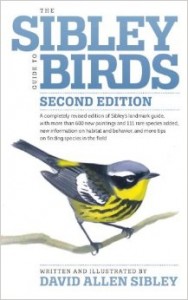 Last week, the highly anticipated second edition of The Sibley Guide to Birds came out on an already crowded field guide market.
Last week, the highly anticipated second edition of The Sibley Guide to Birds came out on an already crowded field guide market.
So, as this latest field guide hits the shelves, let’s take a look at the history of the field guide.
The Early Days
The first Sibley Guide hit the shelves back in 2000 and has since become one of the most beloved field guides for North American birds, but the history of field guides stretches way back to the 19th century. John James Audubon came out with a pretty extensive and now well-known guide called the Birds of America; however, the very large pages made it impossible to actually use in the field.
No, the origin of the first field guide for birds comes from someone you may be less familiar with: Florence Merriam. Merriam, the sister of a naturalist, set out near San Diego in 1889 with a notebook to identify all the birds she saw. She failed at the task because, let’s face it, it can be pretty difficult to ID birds without a little help. So she collected her notes published in Audubon Magazine and formed the groundbreaking bird ID book Birds through an Opera-Glass.
The book itself only described about 70 common species and the text—directed at women and the young—was lighter, unpretentious and anecdotal. It was definitely not the same kind of descriptive text we see in today’s field guides. Still this was one of the first attempts at something that would help bird lovers identify birds.
First True Field Guide
 The first true field guide popped up just five years later in 1904 when Ralph Hoffmann published A Guide to the Birds of New England and Eastern New York. The field guide set the standard of describing field marks, habitat, behavior and other strong indicators that allow a species to be identified.
The first true field guide popped up just five years later in 1904 when Ralph Hoffmann published A Guide to the Birds of New England and Eastern New York. The field guide set the standard of describing field marks, habitat, behavior and other strong indicators that allow a species to be identified.
Hoffmann followed this field guide with another, even more extensive guide called Birds of the Pacific States after he moved out to California.
Evolution of the Field Guide
After Hoffman’s first field guide, others published similar guides for birds, with some publications revolving around identifying a bird by its eggs or by its song. Another type of field guide consistent of all the birds in one area without much info on how to ID them.
Then Roger Tory Peterson came on the scene with his Guide to the Birds in 1934. His guide changed the game and essentially set the standards for modern field guides. His illustrations were clear and his identification system made perfect sense to even someone without any background in science.
Field Guides in the Age of Technology
 Since Peterson’s seminal field guide, there’s been hundreds of different field guides about birds like the National Audubon Field Guides, Kaufman Field Guides, National Geographic Guides, Stokes Guide and tons more. Many of these guides are broken into smaller guides based on regions and each guide tends to have its own touches and images.
Since Peterson’s seminal field guide, there’s been hundreds of different field guides about birds like the National Audubon Field Guides, Kaufman Field Guides, National Geographic Guides, Stokes Guide and tons more. Many of these guides are broken into smaller guides based on regions and each guide tends to have its own touches and images.
This was a fun and productive period of field guides that warrants a deeper discussion than I can’t offer in this brief article.
While we saw a boon for bird guides, chances are that younger birders from here on out will never own another physical copy of a field guide because they can now fit into easily navigable apps on smartphones and tablets. In fact, this is still a great time for field guides because now a single smartphone can hold several digital guides without adding extra weight.
Even though traditional field guides like the latest edition of the Sibley guide are still being released, that’s not always enough. You’ll also be able to pick up the updated Sibley app very soon.


